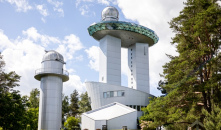Teplov heaters in the Lithuanian Ethnospace Museum

Infrared heating of a museum: Efficiency and Practicality
Infrared heaters are a universal solution for rooms with different functional purposes, including museums. Let's look at why infrared heating can be an effective and practical choice for museum spaces.
Benefits of infrared heaters in museums
- Even distribution of heat: Infrared heaters do not heat the air, but objects and surfaces. This allows heat to be evenly distributed indoors, including exhibition halls and exhibits. Uniform temperature helps preserve valuable artifacts and works of art.
- Safety for exhibits: Infrared heaters do not dry the air or burn oxygen. This makes them safe for fragile materials such as ancient paintings, documents or antiques.
- Economical: Infrared heaters have high efficiency. They direct heat exactly where it is needed, minimizing heating costs for surrounding areas. This helps save energy and reduce heating costs for the museum.
- Versatility of application: Infrared heaters can be installed in different areas of the museum: from exhibition halls to administrative premises. They are not afraid of humidity, temperature changes and other external factors.
Choosing infrared heaters for a museum
- Ceiling infrared heaters: Suitable for uniform heating of large areas. They can be installed above exhibition halls, providing a comfortable temperature for visitors and exhibits.
- Infrared heaters are equipped with thermostats. Suitable for different areas of the museum. They allow you to customize the thermal mode depending on your specific needs.
Important! Choose heaters taking into account the features of museum premises and the safety of exhibits. Our specialists have extensive experience in heating all types of premises. Consultation is free.


